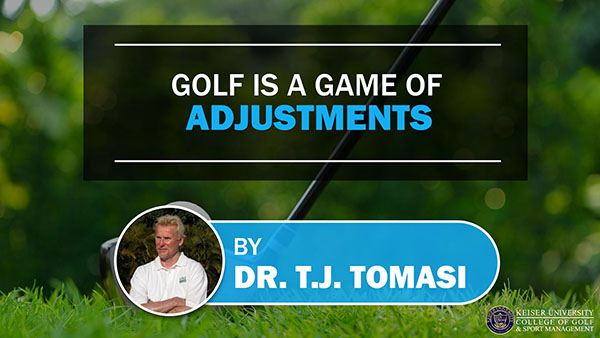Golf is a Game of Adjustments
Golf is a Game of Adjustments
by Dr. T. J. Tomasi
Keiser University College of Golf Senior Faculty and Director of Research

One of the things good players learn to do is adjust their forearm action depending on the kind of specialty shot they need to play.
As an example, when Tiger Woods is smashing an iron out of knurly rough, he understands from experience that he must counter the grass grabbing the neck of the club. When this happens, it turns the face over so much that the ball flies low and to the left of the target.
Tiger anticipates this problem and holds the face open by not allowing his forearms to rotate right over left.
His left elbow flies out in a “chicken-wing” pattern designed to keep the face open.
You have to be pretty strong to do this in situations like this, but this is where he cashed in on all the time spent in the gym, building up his once-skinny frame.
Working out pays off in strength through the ball, which is why I advise all my students that “all things equal, strongest machine wins.”
Note the “all things equal” part, a phrase that suggests that while strength is a key component to being a champion, it is not the only component.
Strength is like money – you only miss it if you don’t have it.
Out of a much better lie, you don’t have to hold the forearms from rotating.
Since the grass is short, you can go ahead and release the club normally. In top competitions, strength can be the deciding factor if they let the rough grow and establish the first and second cuts.

The strong player can play out of both, while the average strength player is more at home in the first cut.
This drill will help you control your forearms: Find a patch of deep grass and place a tee in it to simulate the golf ball.
Make sure the tee is pointing in the direction of the target.
Now make a swing and allow your forearms to roll over through impact.
You’ll notice that the tee squirts to the left with very little height.
Since the tee doesn’t go very far, starting with it instead of a ball allows you to see close-up the difference in height between holding your forearms and rotating them.
Now hold your forearms from rotating and watch the tee as it pops up nice and high.
Next, substitute a real ball and do the same thing.
Takeaway:
In order to play your best golf, you must match your forearm rotation to the demands of the shot.
When you want to keep the face open, keep your lead forearm higher.
When you want to release the clubface, allow your trail forearm to be higher after the ball is on its way.
If you enjoyed this golf tip, and want more information on a golf school in Florida, contact Keiser University College of Golf.














